What is the ghost of the 5G network? How to implement end-to-end network slicing?
When 5G is widely mentioned, network slicing is the most discussed technology. Network operators such as KT, SK Telecom, China Mobile, DT, KDDI, and NTT, as well as equipment vendors such as Ericsson, Nokia, and Huawei, believe that network slicing is the ideal network architecture for the 5G era.
This new technology allows operators to segment multiple virtual end-to-end networks in a single hardware infrastructure. Each network slice is logically isolated from the device to the access network to the transport network to the core network. Different feature requirements for type services.
For each network slice, dedicated resources such as virtual servers, network bandwidth, and quality of service are fully guaranteed. Since the slices are isolated from each other, a slice error or failure does not affect the communication of other slices.
Why 5G requires network slicingFrom the past to the current 4G network, mobile networks mainly serve mobile phones, and generally only do some optimization for mobile phones. However, in the 5G era, mobile networks need to serve devices of all types and needs. More application scenarios include mobile broadband, large-scale Internet of Things, and mission-critical Internet of Things. They all need different types of networks, with different requirements in terms of mobility, billing, security, policy control, latency, and reliability.
For example, a large-scale IoT service connects fixed sensors to measure temperature, humidity, rainfall, and so on. There is no need to switch between the main service phones in the mobile network, location updates and other features. In addition, mission-critical IoT services such as autonomous driving and remotely controlled robots require end-to-end delays of a few milliseconds, which is quite different from mobile broadband services.

5G main application scenarios
Does this mean that we need to build a dedicated network for each service? For example, one service 5G mobile phone, one service 5G large-scale Internet of Things, one service 5G mission-critical Internet of Things. In fact, it is not necessary, because we can cut out multiple logical networks on a separate physical network through network slicing technology, which is a very cost-effective approach!
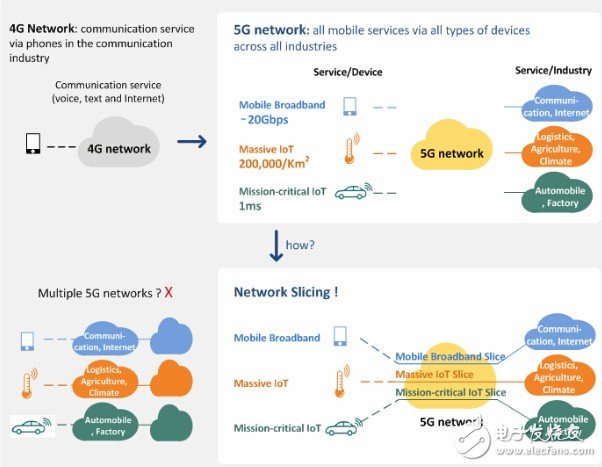
Application requirements for network slicing
The 5G network slice described in the 5G white paper published by NGMN is shown below:
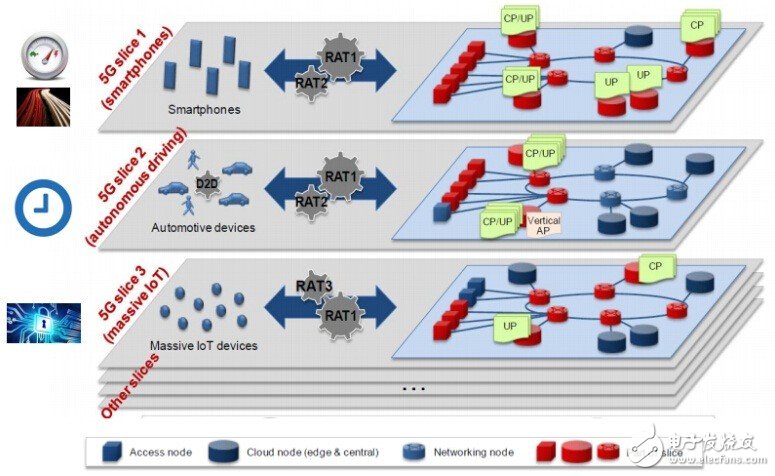
NGMN 5G network slicing schematic
How do we implement end-to-end network slicing? (1) 5G wireless access network and core network: NFVIn today's mobile networks, the main device is a mobile phone. The RAN (DU and RU) and core functions are built by dedicated network equipment provided by the RAN vendor. In order to implement network slicing, Network Function Virtualization (NFV) is a prerequisite. Basically, the main idea of ​​NFV is to deploy all the network function software (ie MME, S/P-GW and PCRF in the packet core and DU in the RAN) to the virtual machine on the commercial server instead of deploying it separately. Network equipment. In this way, the RAN acts as a fringe cloud and the core functionality acts as a core cloud. The connections between the VMs located in the edge and core cloud are configured using SDN. Then, create slices for each service (ie phone slices, large-scale IoT slices, mission-critical IoT slices, etc.).
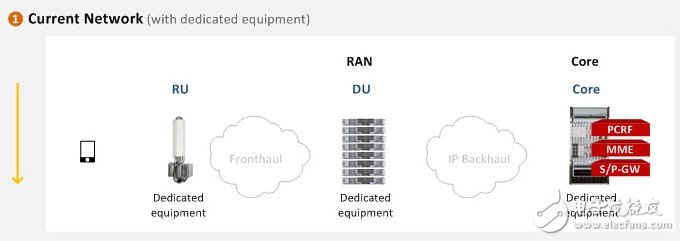
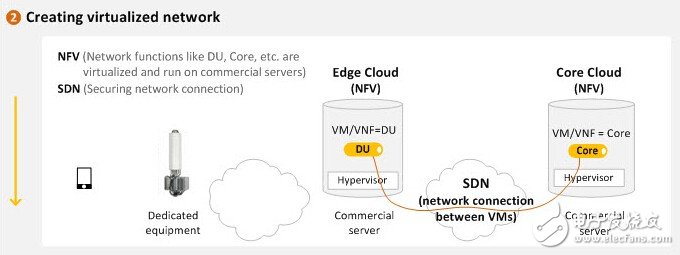

How to implement one of the network slices
The following figure shows how each service-specific application can be virtualized and installed in each slice. For example, a slice can be configured as follows:
(1) UHD Slice: Virtualize DU in the edge cloud, 5G core (UP) and cache servers, and virtualize 5G core (CP) and MVO servers in the core cloud
(2) Phone slicing: Virtualize 5G core (UP and CP) and IMS server with full mobility in the core cloud
(3) Large-scale IoT slicing (eg sensor network): Virtualizing a simple and lightweight 5G core in the core cloud without mobility management
(4) Mission-critical IoT slicing: Virtualization of 5G cores (UP) and related servers (such as V2X servers) in edge clouds for minimizing propagation delays
So far, we need to create dedicated slices for services with different requirements. And the virtual network function is placed at different locations in each slice (ie edge cloud or core cloud) according to different service characteristics. In addition, some network functions such as billing, policy control, etc. may be necessary in some slices, but are not required in other network slices. Operators can customize network slicing the way they want, and it may be the most cost-effective way.

How to implement network slicing two
(2) Network slicing between edge and core cloud: IP/MPLS-SDNSoftware-defined networking, although a very simple concept at the time of introduction, is now becoming more complex. Taking the Overlay form as an example, SDN technology can provide network connectivity between virtual machines on existing network infrastructure.

End-to-end network slice
First, we look at how to ensure that the network connection between the edge cloud and the virtual machine of the core cloud is secure. The network between the virtual machines needs to be implemented based on IP/MPLS-SDN and Transport SDN. In this paper, we mainly discuss IP/MPLS-SDN provided by router vendors. Both Ericsson and Juniper offer IP/MPLS SDN network architecture products. The operation is slightly different, but the connections between SDN-based virtual machines are extremely similar.
In the core cloud is a virtualization server. In the server's hypervisor, run the built-in vRouter / vSwitch. The SDN controller provides tunnel configuration between the virtualized server and the DC G/W router (the PE router that creates the MPLS L3 VPN in the cloud data center), each virtual machine in the core cloud (eg 5G IoT core) and DC G / An SDN tunnel (that is, MPLS GRE or VXLAN) is created between W routers.
The mapping between these tunnels and MPLS L3 VPNs (eg, IoT VPNs) is then managed by the SDN controller. The process is the same in the edge cloud, creating an IoT slice from the edge cloud to the IP/MPLS backbone and up to the core cloud. This process can be implemented based on technologies and standards that have matured so far.
(3) Network slicing between edge and core cloud: IP/MPLS-SDN   What's left now is the mobile front-end network. How do we cut this mobile front-end network between the edge cloud and 5G RU? First, you must first define a 5G preamble network. There are some options in the discussion (for example, by redefining the functionality of DU and RU to introduce a new packet-based preamble network), but no standard definition has yet been made. The figure below is an illustration given in the ITU IMT 2020 Working Group and gives an example of a virtualized preamble network.
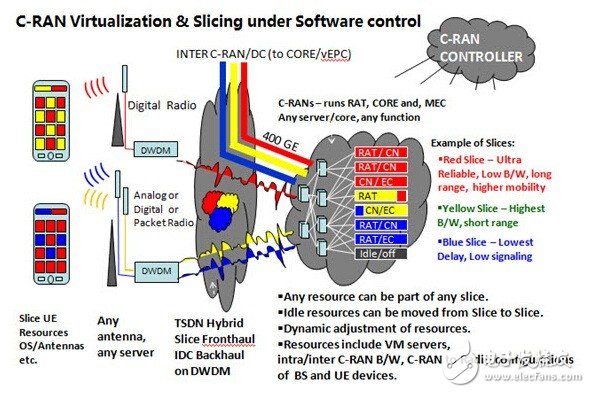
Example of ITU organization 5G C-RAN network slice
The network slicing technology in the 5G era is still evolving, and some concerns and problems remain unresolved. Therefore, we will track the technical updates of operators, suppliers and standardization organizations in Korea and around the world to keep you up-to-date on the technology.
Cummins High Voltage Generators with Cummins Diesel Engine, HV AC Generator
·Engine and alternator shall be mounted on a same frame steel skid.
·Small size, low weight, easy to operating, installation and maintenance.·World most famous brand diesel engine: Cummins
·World famous brand High Voltage AC alternator: Stamford, Leroy Somer, Marathon, Faraday, etc
·Advanced and reliable controller: Auto start, AMF & Remote control by PC with RS232/485
·Full range protect function and alarm shutdown feature.
·Comply with ISO8528 national standard and ISO9001 quality standard.
. Voltage: 3kV, 3.3kV, 6kV, 6.3kV, 6.6kV, 10kV, 10.5kV, 11kV,13.8kV
Voltage Generator,Middle Voltage Generator,6Kv Cummins Generator,Cummins High Voltage Generator
Guangdong Superwatt Power Equipment Co., Ltd , https://www.swtgenset.com
